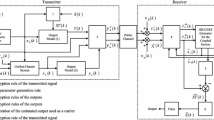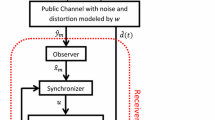Abstract
Synchronization is one of the most challenging topics involved in the development of promising chaos-based secure communication (CBSC) for wireless applications due its direct impact on the error performance and reliability. In this paper, effects of filtering chaotic signals on the synchronization and average bit-error-rate (BER) of CBSC caused by the limited bandwidth of realistic wireless communication channels and detection requirements are investigated. To overcome the possible drawbacks of filtering process, two efficient methods called chaotic signal reconstruction technique (CSRT) and pre-filtering chaos technique (PFCT) are proposed. The well known double scroll chaotic attractor generated from Chua’s circuit is utilized at both transmit and receive nodes as in a drive–response configuration with identical synchronization, and a mathematical model of single-pole low-pass filter is employed in this study. Over Rayleigh fading channel and wide range of filter cut-off frequency (η), simulation results show that as η decreased, lesser than the bandwidth of utilized chaotic signal, the synchronization mean squared error is increased due to the resulting high distortion in the attractor’s ordinary state-space. Consequently, system BER performance is degraded significantly leading to increased possibility of communication link failure. When CSRT from received filtered signal and PFCT of drive chaotic signal are utilized, the achieved results are interesting in terms of robust synchronization and error performance, and provide potential step towards wide adoption of CBSC in future applications.













Similar content being viewed by others
References
Yang, J., & Zhu, F. (2013). Synchronization for chaotic systems and chaos-based secure communications via both reduced-order and step-by-step sliding mode observers. Communications in Nonlinear Science and Numerical Simulation, 18(4), 926–937.
Eisencraft, M., Fanganiello, R., Grzybowski, J., Soriano, D., Attux, R., Batista, A., et al. (2012). Chaos-based communication systems in non-ideal channels. Communications in Nonlinear Science and Numerical Simulation, 17(12), 4707–4718.
Bhatnagar, G., & JonathanWu, Q. (2012). Chaos-based security for fingerprint data during communication and transmission. IEEE Transactions on Instrumentation and Measurement, 61(4), 876–887.
Hou, Y., Chen, H., Chang, J., Yan, J., & Liao, T. (2012). Design and implementation of the Sprott chaotic secure digital communication systems. Applied Mathematics and Computation, 218(24), 11799–11805.
Tam, W., Lau, F., & Tse, C. (2004). A multiple access scheme for chaos-based digital communication systems utilizing transmitted reference. IEEE Transactions on Circuits and Systems-I: Regular Papers, 51(9), 1868–1878.
Puebla, H., & Alvarez-Ramirez, J. (2001). Stability of inverse-system approaches in coherent chaotic communication. IEEE Transactions on Circuits and Systems-I: Fundamental Theory and Applications, 48(12), 1413–1423.
Corron, N., & Hahs, D. (1997). A new approach to communications using chaotic signals. IEEE Transactions on Circuits and Systems-I: Fundamental Theory and Applications, 44(5), 373–382.
Hayes, S., Grebogi, C., & Ott, E. (1993). Communicating with chaos. Physical Review Letters, 70(20), 3031–3034.
Pecora, L., & Carroll, T. (1990). Synchronization in chaotic systems. Physical Review Letters, 64(8), 821–824.
Cuomo, K., & Oppenheim, A. (1993). Circuit implementation of syncronized chaos with applications to communications. Physical Review Letters, 71(1), 65–68.
Dedieu, H., Kennedy, M., & Hasler, M. (1993). Chaos shift keying: Modulation and demodulation of a chaotic carrier using self-synchronizing Chua’s circuits. IEEE Transactions on Circuits and Systems-II: Analog and Digital Signal Processing, 40(10), 634–642.
Al-Hussaibi, W. (2013). Impact of filtering chaotic signals on secure wireless communication systems based Chua’s circuit. Proceedings of IIT’13 (pp. 89–94). Al Ain, Abu Dhabi, UAE.
Chang, W. (2009). Digital secure communication via chaotic systems. Digital Signal Processing, 19(4), 693–699.
Zaher, A. (2009). An improved chaos-based secure communication technique using a novel encryption function with an embedded cipher key. Chaos, Solitons & Fractals, 42(5), 2804–2814.
Murali, K., Yu, H., Varadan, V., & Leung, H. (2001). Secure communication using a chaos based signal encryption scheme. IEEE Transactions on Consumer Electronics, 47(4), 709–714.
Kiani-B, A., Fallahi, K., Pariz, N., & Leung, H. (2009). A chaotic secure communication scheme using fractional chaotic systems based on an extended fractional Kalman filter. Communications in Nonlinear Science and Numerical Simulation, 14(3), 863–879.
Changchien, S.-K., Huang, C.-K., Nien, H.-H., & Shieh, H.-W. (2009). Synchronization of the chaotic secure communication system with output state delay. Chaos, Solitons & Fractals, 39(4), 1578–1587.
Zheng, G., Boutat, D., Floquet, T., & Barbot, J. (2009). Secure communication based on multi-input multi-output chaotic system with large message amplitude. Chaos, Solitons & Fractals, 41(3), 1510–1517.
Jung, P., Baier, P., & Steil, A. (1993). Advantages of CDMA and spread spectrum techniques over FDMA and TDMA in cellular mobile radio applications. IEEE Transactions on Vehicular Technnology, 42(3), 357–364.
Kolumban, G., Kennedy, M., & Chua, L. (1997). The role of synchronization in digital communications using chaos-part I: Fundamentals of digital communications. IEEE Transactions on Circuits and Systems-I: Fundamental Theory and Applications, 44(10), 927–936.
Kolumban, G., Kennedy, M., & Chua, L. (1998). The role of synchronization in digital communications using chaos-part II: Chaotic modulation and chaotic synchronization. IEEE Transactions on Circuits and Systems-I: Fundamental Theory and Applications, 45(11), 1129–1140.
Kolumban, G., & Kennedy, M. (2000). The role of synchronization in digital communications using chaos-part III: Performance bounds for correlation receivers. IEEE Transactions on Circuits and Systems-I: Fundamental Theory and Applications, 47(12), 1673–1683.
Badii, R., Broggi, G., Derieghetti, B., & Ravani, M. (1988). Dimension increase in filtered chaotic signals. Physical Review Letters, 60(11), 979–982.
Mitschke, F., Moller, M., & Lange, W. (1988). Measuring filtered chaotic signals. Physical Review A, 37(11), 4518–4521.
Chennaoui, A., Pawelzik, K., & Liebert, W. (1990). Attractor reconstruction from filtered chaotic time series. Physical Review A, 41(8), 4151–4159.
Rosenstein, M., & Collins, J. (1994). Visualizing the effects of filtering chaotic signals. Computer and Graphics, 18(4), 587–592.
Pecora, L., & Carroll, T. (1996). The effect of filtering on communication using synchronized chaotic circuits. Proceedings of IEEE ISCAS, 3, 174–177.
Zhu, L., Lai, Y., Hoppensteadt, F., & Bollt, E. (2003). Numerical and experimental investigation of the effect of filtering on chaotic symbolic dynamics. Chaos, 13(1), 410–419.
Harb, A., Al-Hussaibi, W., & Khadra, L. (2003). Effects of filtering chaotic signals of power electronic circuit. International Journal of Modeling and Simulation, 23(2), 129–134.
Matsumoto, T., Chua, L., & Komuro, M. (1985). The double scroll. IEEE Transactions on Circuits and Systems, 32(8), 798–818.
Chua, L., & Lin, G. (1990). Canonical realization of Chua’s circuit family. IEEE Transactions on Circuits and Systems, 37(7), 885–902.
Cruz-Hernandez, C., & Romero-Haros, N. (2008). Communicating via synchronized time-delay Chua’s circuits. Communications in Nonlinear Science and Numerical Simulation, 13(3), 645–659.
Gamez-Guzman, L., Cruz-Hernandez, C., Lopez-Gutierrez, R., & Garcia-Guerrero, E. (2009). Synchronization of Chua’s circuits with multi-scroll attractors: Application to communication. Communications in Nonlinear Science and Numerical Simulation, 14(6), 2765–2775.
Cheng, C. (2012). Robust synchronization of uncertain chaotic systems subject to noise and its application to secure communication. Applied Mathematics and Computation, 219(5), 2698–2712.
Mata-Machuca, J., Martinez-Guerra, R., Aguilar-Lopez, R., & Aguilar-Ibanez, C. (2012). A chaotic system in synchronization and secure communications. Communications in Nonlinear Science and Numerical Simulation, 17(4), 1706–1713.
Al-Hussaibi, W., & Ali, F. (2012). Generation of correlated Rayleigh fading channels for accurate simulation of promissing wireless communication systems. Elsevier: Simulation Modelling Practice and Theory, 25(4), 56–72.
Sklar, B. (1997). Rayleigh fading channels in mobile digital communication systems, part I: Characterization. IEEE Communications Magazine, 35(7), 90–100.
Albano, A., Muench, J., & Schwartz, C. (1988). Singular-value decomposition and the Grassberger–Procaccia algorithm. Physical Review A, 38(6), 3017–3026.
Author information
Authors and Affiliations
Corresponding author
Rights and permissions
About this article
Cite this article
Al-Hussaibi, W.A. Filtering effects on the synchronization and error performance of promising wireless chaos-based secure communications. Wireless Netw 21, 1957–1967 (2015). https://doi.org/10.1007/s11276-015-0897-0
Published:
Issue Date:
DOI: https://doi.org/10.1007/s11276-015-0897-0




